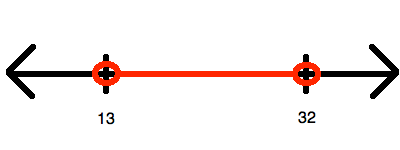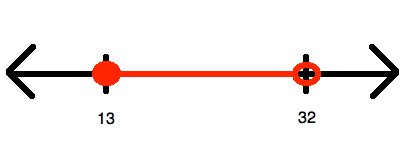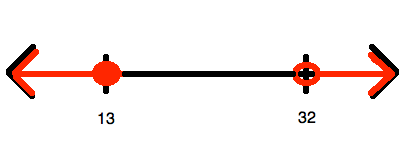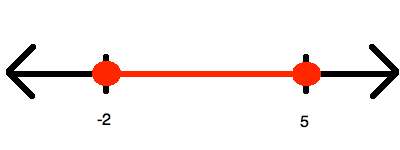All SAT Math Resources
Example Questions
Example Question #1571 : Sat Mathematics
Divide:
Anytime a positive number is divided by a negative number, or vice versa, the end result is a negative number. Find the common factors.
Example Question #44 : Integers
Divide:
In order to divide, it is necessary to simplify the numerator and denominator first.
Divide both negative numbers. Two negatives divided will result in a positive number.
The answer is 
Example Question #1 : How To Add Negative Numbers
Add:
Anytime a negative number is added, it is similar to subtraction. Recovert the expression to the correct form. Simplify.
The correct answer is 
Example Question #51 : Integers
Add the negative numbers:
In order to add the negative numbers, we need to eliminate the double signs and the parentheses. A positive and a negative sign will result in a negative sign.
Evaluate the terms on the right.
The answer is:
Example Question #1 : How To Add Negative Numbers
a, b, c are integers.
abc < 0
ab > 0
bc > 0
Which of the following must be true?
a > 0
a – b > 0
b > 0
ac < 0
a + b < 0
a + b < 0
Let's reductively consider what this data tells us.
Consider each group (a,b,c) as a group of signs.
From abc < 0, we know that the following are possible:
(–, +, +), (+, –, +), (+, +, –), (–, –, –)
From ab > 0, we know that we must eliminate (–, +, +) and (+, –, +)
From bc > 0, we know that we must eliminate (+, +, –)
Therefore, any of our answers must hold for (–, –, –)
This eliminates immediately a > 0, b > 0
Likewise, it eliminates a – b > 0 because we do not know the relative sizes of a and b. This could therefore be positive or negative.
Finally, ac is a product of negatives and is therefore positive. Hence ac < 0 does not hold.
We are left with a + b < 0, which is true, for two negatives added must be negative.
Example Question #1 : Number Lines And Absolute Value
If 0 < n < 1, then which of the following is the smallest?
1/n2
–1/n3
n2
n3 – 1
–1/n
–1/n3
First, it will help us to determine which of the answer choices are positive and which are negative.
Because n is positive, we know that n2 is positive, because any number squared is positive. Similarly, 1/n2 is also positive.
Let's look at the answer choice –1/n. This must be negative, because a negative number divided by a positive one will give us a negative number. Similarly, –1/n3 will also be negative.
The last choice is n3 – 1. We are told that 0 < n < 1. Because n is a positive value less than one, we know that 0 < n3 < n2 < n < 1. In other words, n3 will be a small positive value, but it will still be less than one. Thus, because n3 < 1, if we subtract 1 from both sides, we see that n3 – 1 < 0. Therefore, n3 - 1 is a negative value.
All negative numbers are less than positive numbers. Thus, we can eliminate n2 and 1/n2, which are both positive. We are left with –1/n, –1/n3, and n3 – 1.
Let us compare –1/n and –1/n3. First, let us assume that –1/n < –1/n3.
–1/n < –1/n3
Multiply both sides by n3. We don't need to switch the signs because n3 is positive.
–n2 < –1
Multiply both sides by –1.
n2 > 1.
We know that n2 will only be bigger than 1 when n > 1 or if n < –1. But we know that 0 < n < 1, so –1/n is not less than –1/n3. Therefore, –1/n3 must be smaller.
Finally, let's compare –1/n3 and n3 – 1. Let us assume that –1/n3 < n3 – 1.
–1/n3 < n3 – 1
Multiply both sides by n3.
–1 < n6 – n3
Add one to both sides.
n6 – n3 + 1 > 0. If this inequality is true, then it will be true that –1/n3 is the smallest number.
Here it will be helpful to try some values for n. Let's pick n = 1/2 and see what happens. It will help to use our calculator.
(1/2)6 – (1/2)3 + 1 = 0.891 > 0.
Therefore, we suspect that because n6 – n3 + 1 > 0, –1/n3 is indeed the smallest number. We can verify this by trying more values of n.
The answer is –1/n3.
Example Question #2 : Number Lines And Absolute Value
On a real number line, x1 = -4 and x2 = 14. What is the distance between these two points?
10
-18
4
18
18
The distance between two points is always positive. We calculate lx2 - x1l, which will give us the distance between the points.
|14- (-4)| = |14+4| = |18| = 18
Example Question #3 : Number Lines And Absolute Value
Which of the following is a graph for the values of 






To begin, you must simplify so that you "isolate" 

Now, this inequality represents all of the numbers between 13 and 32. However, it does include 


Example Question #1572 : Sat Mathematics

Which of the following inequalities is represented by the number line shown above?
Since the inequality represents one range of values between two end points (both of which are included, given the sign being "less than or equal"), you know that whatever you answer, it must be convertible to the form:
Now, you know that it is impossible to get this out of the choices that have no absolute values involved in them. Therefore, the only options that make sense are the two having absolute values; however, here you should choose only the ones that have a 
The wrong answer is simplified in this manner:
And you can stop right here, for you know you will never have 
The other option is simplified in this manner:
This is just what you need!
Example Question #1573 : Sat Mathematics
Which of the following is a graph for the values of 






Begin by solving for 
Now, this is represented by drawing an open circle at 6 and graphing upward to infinity:

Certified Tutor
Certified Tutor
All SAT Math Resources





















































